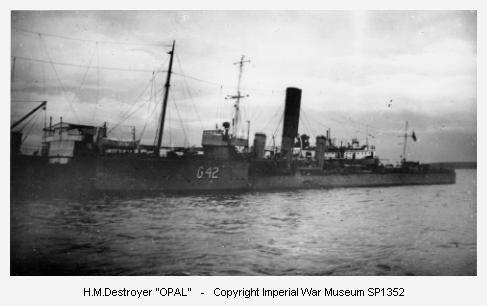Name HMS Opal Launched 11 September 1915 Builder William Doxford & Sons | Beam 27 ft 6 in (8.38 m) Length 82 m | |
 | ||
Fate Wrecked on 12 January 1918 Displacement 994 long tons (1,010 t) standard1,042 long tons (1,059 t) full load Draught 8 ft 8 in (2.64 m) mean10 ft 6 in (3.20 m) maximum | ||
HMS Opal was an Admiralty M-class destroyer of the Royal Navy. She served in the First World War following her construction at Sunderland in 1915. Attached to the 12th Destroyer Flotilla based with the Grand Fleet at Scapa Flow, Opal had an eventful short life, which ended in shipwreck after two and a half years of service.
Contents
Construction and design
Opal was one of 25 destroyers (consisting of 22 M-class destroyers and three Parker-class flotilla leaders) ordered in late November 1914 as part of the Third War Programme. The M class was the latest class of destroyers ordered for the Royal Navy before the outbreak of the First World War, and this order was one of a series of large orders for destroyers of this class placed in the early months of the war which resulted in 90 ships being ordered by May 1915 in addition to ships ordered prior to the outbreak of the war.
Opal was laid down at William Doxford & Sons shipyard in Sunderland on 1 February 1915, and was launched on 11 September 1915. The ship reached a speed of 34.31 knots (63.54 km/h; 39.48 mph) during sea trials early in 1916, and commissioned in April 1916.
Service
On commissioning, Opal joined the 12th Destroyer Flotilla, based at Scapa Flow as part of the Grand Fleet. Opal took part in the Battle of Jutland where the Twelfth Flotilla supported the Grand Fleet, and both attacked and was attacked during the general action. She also participated in other major fleet sorties during the next two years as well as pursuing her regular duties of minesweeping, convoy protection and anti-submarine patrols in the North Sea.
On 12 January 1918, Opal joined her sister ship Narborough and the light cruiser Boadicea in a night patrol to hunt German auxiliary warships suspected to be laying mines on the Scottish coast. By 17:30, the weather had deteriorated to such an extreme degree that the destroyers were in danger of swamping and foundering and visibility was near zero. Fearing that her companions might sink, Boadicea ordered Opal and Narborough back to Scapa Flow while she continued alone. For the next four hours, Opal regularly sent reports indicating her course and intention to return, but at 21:27, a garbled message stating have run aground was received, followed by silence. The weather was so atrocious that no vessels could be despatched until the following morning, and it was two days before Opal was found, battered, broken and empty on the Clett of Crura off the east coast of South Ronaldsay. Narborough was found in a similar position nearby. One survivor — William Sissons — was later located on a small islet, and he related that the ships had been sailing a regular slow course making frequent soundings and radio reports, but had suddenly crashed headlong into the rocks, probably due to a navigation error by Opal's captain. Both wrecks were abandoned and broken up by the sea over the next few weeks taking the bodies of both crews, bar the single survivor, with them.
